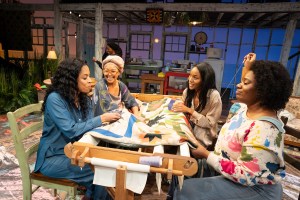Straiges was most recently at work in New York on Classic Stage Company’s Caucasian Chalk Circle. He is also the designer for People’s Light & Theatre Company’s upcoming production of Michael Frayn’s Noises Off. TheaterMania took this opportunity to catch up with him about his career.
How did you first get involved with People’s Light & Theatre?
My agent asked if I’d be interested in designing Dividing the Estate there. They sent me the play, and I met the artistic director, Abbie [Adams], and liked her. It was successful, so they invited me back to design a production of Shipwrecked!
Noises Off will be my third show with them.
Have you worked on Noises Off before?
I have. In fact, that’s why I was able to do this schedule-wise. I had to change the design a little bit, but the director at People’s Light liked what I did earlier. The director who I worked with when I designed it at Hartford Stage wanted the set to look like the British sitcom Keeping Up Appearances. So that’s what I did, and I had some really good photographs to help re-create it.
But basically all I’m doing is designing what the playwright outlined. He calls for a certain number of doors and a mezzanine, and because it’s farce, you have to do exactly what it says.
In a process like that, where do you find the ways to add your own personal touches?
Well, it takes place in a country home, an old possum factory — whatever that is. I had fun with having stuffed foxes and a moose head and a picture of the Queen. That kind of British humor is what I added to it.
What keeps you going back to a specific theater?
The staff. People’s Light has very nice people. A really good painter, props department, carpenters. The artistic director, Abbie, is very smart, friendly. And they do good shows. It’s built on an old farm property. The lobby is all beautiful stone. The trees and flowers on the grounds are beautiful. It’s close to Valley Forge, which is fun.
Are there specific artists who inspire you, in theater or otherwise?
Well, the people I admired when I came into the business were designers like Tony Walton, Robert Wagner, and Ming Cho Lee. I use a lot of art in my designs. I’ve done a lot of designs…based on Joseph Cornell’s work. I did a show at Yale all based on Louise Nevelson’s work. When I did a Giselle in L.A., the design was inspired by some of Monet’s paintings.
How did you get involved with the original production of Sunday in the Park with George?
I was friends with James Lapine. And one day he said he wanted to talk to me about a musical-theater project, and he said it [was] about a painter, Georges Seurat. And I don’t think I knew who Seurat was. I said, “well, who’s doing the music?” And he said “Stephen Sondheim.” And I just said, “Come on.” You know?
I think the first time I met Steve was when I presented the white model. We went to his house, and we put the model on the coffee table, and Steve went to get us drinks, and I was leaning down putting the figures in the model. And Steve came and knelt down beside me, looking at the model. And I was shaking. There were two people in the world [whom] I admired: Steve Sondheim and Elia Kazan, and I got to work with both of them. So I got my wish.
The show wasn’t fully written when you went into rehearsal. What was that like?
It was pretty crazy. The first act was pretty much done; the second act was not. When they presented it, I think it was more like a sketch. When we were doing it at Playwrights Horizons, they would perform at night. My assistants and I would come in at around midnight, after the performance, and we’d work all night on those paintings and leave in the morning. Then the actors would rehearse in the afternoon and perform at night, and we’d go back in and work. It took a long time to do all that.
When we transferred to Broadway, the second act still wasn’t finished. I remember the day Steve added these two songs [“Children and Art” and “Lesson #8”] — and that’s when it was finished. It was a matinee, I remember, and we were just ecstatic. They’d put it together.
What inspired your design for Into the Woods?
James Lapine had a country house in upstate New York. And to go to the meat market you had to walk through the woods. Nothing was level — it’s all these hills and curves. You’re never walking in a straight path…Jim Lapine likes to have a lot of things moving and swirling. He’s really good at maneuvering all this stuff. So there were a lot of curved pieces and ramps.
There again, I was influenced by Cornell. It’s really hard — how do you put trees onstage? Making phony trees is very difficult to do. But there’s a Cornell box and he had these branches painted silver, and behind the branches was a little doll. And that was it. We made all these iron traceries, and we wove thousands of real branches through it.
How does it feel to have your work on those two productions preserved on film?
The thing is, when I watch those, especially Sunday, I’d like to get a crack at doing it again. There are mistakes that I made. When the dog Spot comes up out of the floor, he’s in a blackish-green shaded area, but Spot is pretty much black. And around his legs, I went to a lighter shade of green, so you could see him. It just looks wrong. And the frame is too small for the boys bathing unit…And the two soldiers, the actor and the cutout — they’re supposed to be the same color, but the costume is one thing, and mine is another.
You know, at the end of Gone with the Wind, there’s a moment when Scarlett runs out the door and touches a column holding up the porch, and the column moves! It wasn’t secure. And I thought, how is it nobody caught that?
I’ll tell you something else. If you look at the new World Trade Center from the Brooklyn side, you can see the final piece of the tower is crooked. I’m sure they must know that, but whenever I sit on the promenade and look at that, I think the architect must be going crazy.











